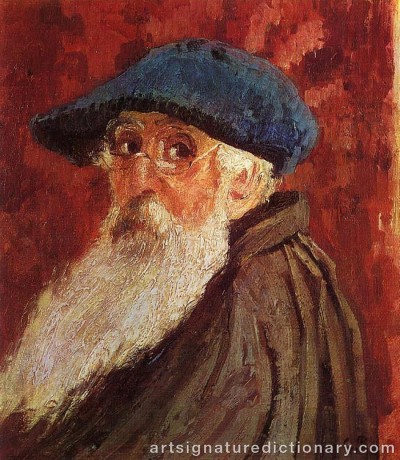
Camille PISSARRO
1830–1903, France
Also known as: CP
Biography
Discover the life and artistic journey of Camille PISSARRO (born 1830, France, died 1903, France), including key biographical details that provide essential context for signature authentication and artwork verification. Understanding an artist's background, artistic periods, and career timeline is crucial for distinguishing authentic signatures from forgeries.
Camille Pissarro was one of the most influential members of the French Impressionist movement, not only as an artist but also as a teacher, and he was the only artist to participate in all eight Impressionist exhibitions.
Born in St. Thomas in the Danish West Indies, Camille was sent to school in Paris at the age of 11 where he displayed a talent for drawing. In 1855, having convinced his parents of his determination to pursue a career as an artist rather than work in the family import/export business, he returned to Paris where he studied at the Academie Suisse alongside Claude Monet.
At the outbreak of the Franco-Prussian war in 1870, Camille moved to England. With Monet he painted a series of landscapes around South-East London as well as studying English landscape painters in the museums. When he returned home to Louveciennes a year later, Camille discovered that all but 40 of the 1500 paintings he had left there - almost twenty years’ work – had been vandalised.
In 1872 Camille settled in Pontoise where he remained for the next ten years, gathering a close circle of friends around him. Gauguin was among the many artists to visit him there and Cézanne, who lived nearby, came for long periods to work and learn. These were also the years of the Impressionist group exhibitions in which Camille played a major role, but which earned him much criticism for his art. While mainly interested in landscape, he introduced figures (generally peasants conducting their rural occupations) and animals into his work and these became the focal point of the composition. It was this unsentimental and unliterary approach, and the complete absence of any pretence, that seemed to stop his work from finding appreciation with the general public.
In the last years of his life Camille divided his time between Paris, Rouen, Le Havre and his home in Eragny and painted many series of different aspects of those cities, with varying light and weather effects. Many of these paintings are considered amongst his best and make a fitting finale to his long and eventful career.
When Camille Pissarro died in the autumn of 1903 he had finally started to gain public recognition and today, of course, his work can be found in many of the most important museums and private collections throughout the world.
Source: http://www.pissarro.net/
Camille Pissarro est un artiste français né en 1830 et décédé en 1903. Il participe au mouvement impressionniste aux côtés d’artistes comme Monet. Puis, il adhèrera plus tard aux principes du Postimpressionnisme. Originaire de Saint-Thomas, il est envoyé à Paris à l’âge de 12 ans. Sensible très tôt à la peinture, il développe ses compétences de peintre en parallèle de ses études. De 1852 à 1855, il vit au Venezuela. De retour à Paris, il travaille aux côtés de Corot et Courbet. Il s’associe avec Monet et Cézanne autour de valeurs et d’intérêts artistiques communs. En effet, les institutions de l’époque sont opposées à leur peinture atypique présentant une touche divisée, des couleurs pures parfois posées directement au couteau sur la toile. Pissarro épouse Julie Vellay en 1871 et ils s’installent en périphérie de la capitale, là où l’artiste peut peindre la nature et les villages en plein-air plutôt que dans un atelier parisien. Durant la guerre qui oppose la France à la Prusse (dès 1870), la famille Pissarro s’installe en Angleterre pendant un an. De retour à Paris, il continue de peindre avec ses compagnons artistes partageant la même vision de l’art et du monde que lui. En 1873, ils forment un groupe de 15 artistes, désirant créer un Salon indépendant. L’année suivante, le groupe présente sa première exposition : le « Salon des Refusés », exposition qui devient le point de départ de l’Impressionnisme. Dans les années 1880, Pissarro entre dans sa période postimpressionniste, utilisant le pointillisme. Il fréquente les artistes Seurat et Signac. A cause d’une infection à un œil, il ne peut plus peindre en plein-air mais depuis chez lui derrière une fenêtre. Il décède en 1903, son corps repose encore aujourd’hui au cimetière du Père Lachaise.
Source: www.artprecium.com
Camille Pissaro (1830-1903), den äldste och mest tongivande av impressionisterna, reste till England tillsammans med Monet under 1870-71 års krig och hämtade impulser direkt från detta land. Impulserna fick bl.a. uttryck i Pissaros förkärlek för gatumotiv.
Explore other artists
Discover other notable artists who were contemporaries of Camille PISSARRO. These artists worked during the same period, offering valuable insights into artistic movements, signature styles, and authentication practices. Exploring related artists makes it easier to recognize common characteristics and artistic conventions of their era.